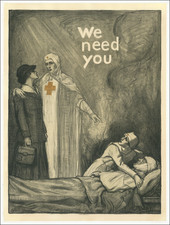Search
Albert Edward Sterner (March 8, 1863 – December 16, 1946), a distinguished British-American artist, carved a unique space in the intersecting worlds of painting, printmaking, and illustration. Renowned for his adept and fluid draftsmanship, Sterner's artistic journey is marked by critical engagements with major periodicals such as Century Magazine, Harper's, and Life, where he not only contributed but shaped the visual culture of his time.
Born into a Jewish family in London, Sterner's formative years were influenced by diverse cultural experiences across Europe. He attended King Edward's School in Birmingham, followed by studies in Germany. His artistic talents were honed under the tutelage of Jean-Léon Gérôme and Gustave Boulanger at the prestigious studios in Paris. In 1879, he migrated to the United States, settling in Chicago where his family had established themselves earlier, and where his brother, Frederick Sterner, would later emerge as a noted architect.
Sterner's opened his own studio in New York in 1885, marking the start of a prolific period of contributions to leading magazines. His artistic education continued at the Académie Julian in Paris in 1888, further solidifying his skills. Sterner’s illustrations for works like G.W. Curtis' Prue and I and the Works of Edgar Allan Poe underscored his reputation as a premier black-and-white artist. His painting, "The Bachelor", exhibited at the 1900 Paris Exposition, won him a bronze medal, affirming his place in the international art scene.
Returning to America in 1918, Sterner began teaching at the Art Students League of New York, influencing a generation of artists. His work during this period diversified into nudes, religious themes, landscapes, and still-life, reflecting a broadening of his artistic repertoire. Notably, his portraits of eminent patrons like the Vanderbilts, Whitneys, and Wideners earned him immense acclaim.
Sterner's works were exhibited at prestigious institutions such as the Pennsylvania Academy of the Fine Arts, Carnegie Museum, and the Art Institute of Chicago. His career was punctuated with accolades, including the Carnegie Prize at the National Academy of Design in 1941, which celebrated his enduring influence on American art.
Albert Sterner's legacy is preserved not only through his artworks but also through his impact on students like Elizabeth Cady Stanton Blake and Jacob Burck, who carried forward his artistic ethos. His ability to blend European techniques with American sensibilities made him a pivotal figure in the art world of his time, bridging the gap between the traditional and the modern, the classical and the contemporary. His death in 1946 was noted by the New York Times as the loss of a luminary best known for his portraits and diverse subject matter, attesting to a life devoted to the pursuit of artistic expression and education.

